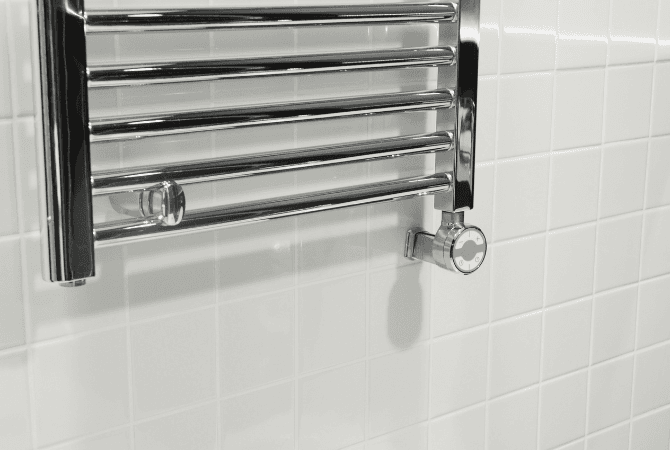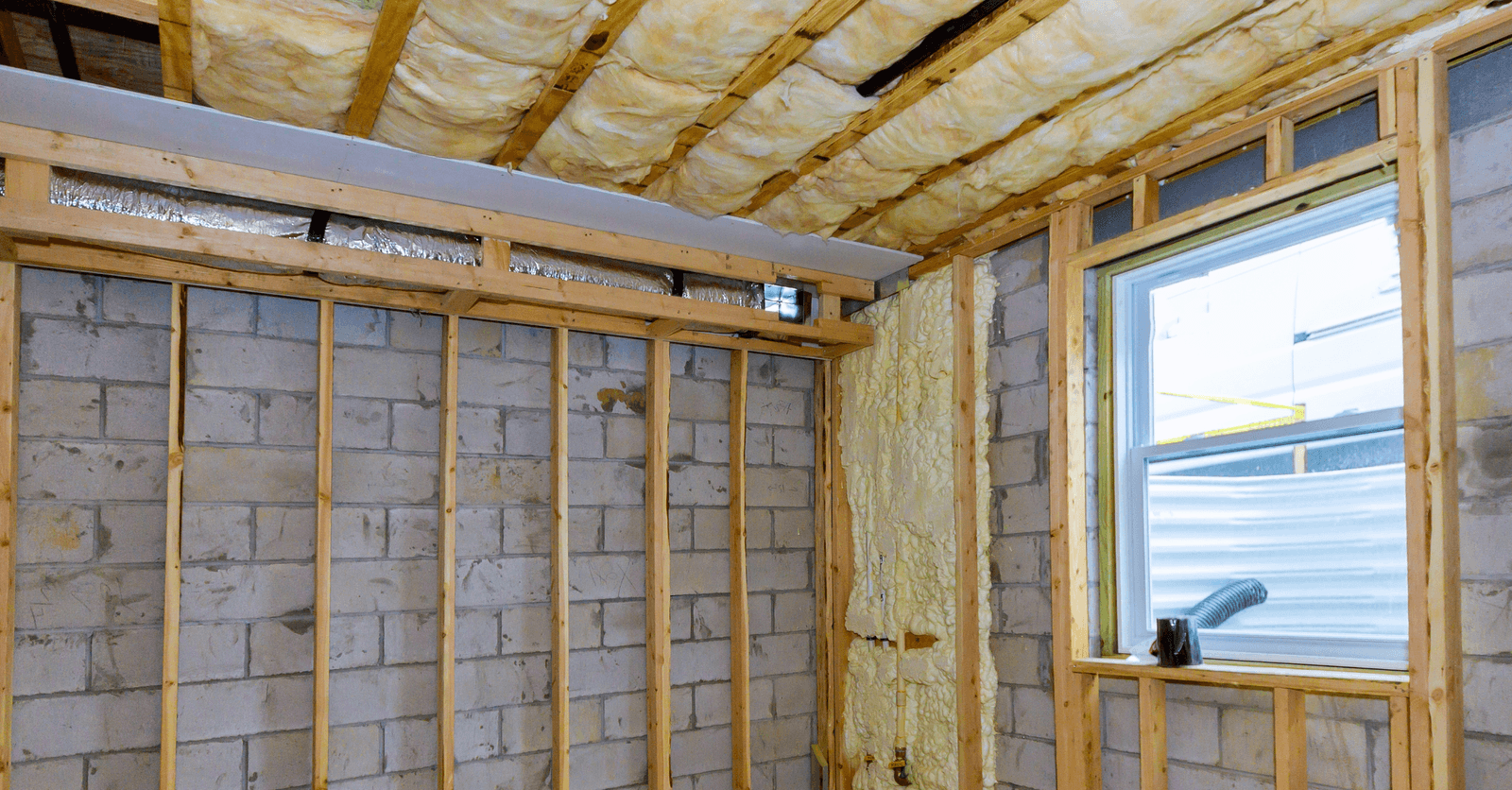
Getting undressed in a bathroom should always be a treat. However, it often turns into an ordeal. And, as it turns out, the secret lies within the heating system, from which we expect an immediate, cozy warmth. What more could you ask for from a bathroom heater? So, why not get one that’s programmable and doubles as a towel warmer?
A wall-mounted heater, typically an electric heater, is, without a doubt, the answer you’re looking for. But, what about a heated floor? Well, let’s get down to the nitty-gritty of bathroom heating systems.
Bathroom Heating System Options: Heated Floor

The number-one reason for installing underfloor heating is its cozy warmth, which is made possible by a radiant heat system. The tubing is fitted onto the insulation, which lays on a concrete slab. Then, the tubing is encased in the screed, which will then serve to diffuse the heat. However, heated floors have pros and cons.
What are the benefits of heated floors?
Doesn’t make a mess;
Doesn’t take up space;
Improves blood flow;
Diffuses heat evenly.
The last bullet point is especially important since it’s the one that creates that cozy, warm feeling one wants. Whereas, with an electric bathroom heating system, there can be a 5°C difference between the topmost section of the room and the flooring. Furthermore, underfloor heating coincides with our physiology since it can limit heat loss through our feet. As a matter of fact, it’s the primary source of heat loss when it comes to our bodies. As such, heated floors are the ideal solution. Alas, not everything is pretty and pink with a bow on top when it comes to underfloor heating.
What are the downsides of heated floors?
Installation costs ($12 to $36/sq. ft. and $240 and $280 for labour);
The height of the floor (an extra ½ inch on average);
Its inertia.
The last point is, in the long run, the most inconvenient. While the warmth is cozy, it does take a few hours for the temperature in the room to rise from 3°C to 4°C (37 to 39°F).
Types of Bathroom Convectors

While you’re looking for the best bathroom heaters, you’ll come across three types of electric heating systems:
Convector;
Fan-forced;
Wall-mounted.
Here’s the rundown on all three heating systems to help narrow down your selection.
What’s the difference between convection, fan-forced, and wall-mounted heaters?
Convection
A convection heater works based on the principles of convection, which is explained by the motion of heated fluid. When it comes to a bathroom convection heater, the air in the room will be set in motion by a difference in density resulting from the temperature. More precisely, inside the heating system, an electric resistance increases the temperature as a result of electricity flow. The heat that’s released is sent to a heating plate, which is made of ceramic, aluminum, or carbon. When the heating plate comes into contact with the air, its temperature will rise. Since warm air naturally rises, the airflow created inside the room will allow the cold air coming from the ceiling to be warmed.
Fan-forced heater
The fan-forced heating system works just like the convector, but with a bonus ventilation system. As such, the system pushes the warm air and releases the heated air throughout the bathroom, thus heating the bathroom at a faster rate.
Wall-mounted
This is a ventilation unit that restores the heat released with a heat pump. However, it has one peculiarity: it’s reversible. During the summer, it can release cold air, whereas, during wintertime, it can produce heat. Its excellent yield makes it a great heating system option.
Nonetheless, it’s not all about heating, one also has to account for its shape, power, size, remote control (timer), and all of its other features.
Fan-Forced Heaters: Prices & Features

1. Electric bathroom heater, wagering on power
Convectair C-20 Calypso Fan-Forced Heater
When we say “power,” we’re talking about a 2000W heating capacity. It’s twice as much as a vacuum, as much as a standard oven, or a AAA washing machine. Therefore, amongst the other bathroom heaters, this fan-forced heater is bar-none.
Price & characteristics:
Height: 16 in (41 cm)
Width: 12 in (31 cm)
Power: 2000W
Weight: 11.9 lb (5.4 kg
Thermostat: Yes
Programmable: Yes
Price: $640
2. Wall-mounted electric heating
Convectair C15 Soprano Fan-Forced Heater
The benefit of this type of wall-mounted, bathroom heating system is that you can indeed, mount it. It’s a significant space gain in a room that’s often not very big, to begin with. The maximum power output by this compact unit is pretty interesting since it generates between 750 and 1500W of power. However, this unit’s biggest advantage is that it’ll allow you to fit in a small linen cabinet or another piece of furniture in your bathroom. Why not store your towels there, once another type of heating system has dried them?
Price & characteristics:
Height: 9.06 in (23 cm)
Width: 34.29 in (87 cm)
Power: 750 to 1500W
Weight: 6.75 lb (3 kg)
Thermostat: Yes
Programmable: N/A
Price: $342
3. Heated towel rack, a worthy unit
Convectair Agagio fan-forced heater fitted with towel bars
This is probably the most researched type of electric bathroom heating unit. The latter allows you to bundle up in a warm towel right after taking a shower or bath. Also mounted, this system has a rack to hang towels. It’s equipped with a thermostat for optimal temperature settings, and it typically has a 0.1°C (32°F) accuracy. Its only problem is its size. The towel bar heating unit for bathrooms is space-consuming. Smaller models are usually 23.38 inches (58 cm) high and 62.99 inches (157.5 cm) high for larger units. As for its weight, it usually weighs over 20 pounds (10 kg). In other words, this electric towel drying system doesn’t fit all bathrooms.
Heater features:
Height: 23.38 in (60 cm)
Width: 6.75 in (17 cm)
Power: 1400W
Weight: 8.12 lb (3.7 kg)
Thermostat: Yes
Programmable: Yes
Price: $733.99
Bathroom Wall-Mounted Heater: Price & Features

Global Commander Wall Heater
This heating unit is perfect for small spaces; it’s compact, with good power, and makes for a worthy option to quickly warm up a bathroom.
Price & characteristics:
Height: 16.5 in (42.1 cm)
Width: 13.44 in (34.1 cm)
Power: 1500W
Weight: N/A
Thermostat: Yes
Programmable: N/A
Price: $219.02
Bathroom Convector: Price & Features

Convectair Allegro II 14 C15
This wall-mounted heating system is powered by natural convection. It’s noiseless, and it ensures even heat distribution with minimal dust generation. Its only downside: One must have a good amount of wall space available to mount it.
Price & characteristics:
Height: 14 ⅛ in (36 cm)
Width: 33 ⅜ in (84.9 cm)
Weight: 15 lb (6.8 kg)
Power: 1500W
Thermostat: Yes
Programmable: Yes
Price: $648
Where in the bathroom should it be installed?
Heated flooring isn’t for you? Well then, note the following precautionary measures prior to installing a wall-mounted bathroom heating system:
Opt for a heating unit with a timer;
Never mount a heating system above a bathtub or a shower (or allow for at least 6.5 ft (2.5 metres) of clearance;
If the system is positioned 24 inches (60 cm) or closer to your tub, opt for a dual insulation heating unit, minimum, with a water guard surface to protect against water splashing;
Beyond this clearance, you can opt for a system that’s less safeguarded, with a built-in external outlet only, if it has a water guard.
Get 3 renovation quotes for your bathroom heating system
RenoQuotes.com can help you get quotes for your bathroom air conditioning and heating project. If you submit your project to us, we’ll put you in contact with top-rated contractors. Fill in the form on the homepage (it only takes a few minutes), and you will get estimates from trusted professionals.
Dial 1-844 828-1588 to speak with one of our customer service representatives.
Looking for something else?
Related articles
The latest industry news, interviews, technologies, and resources.

Editorial Team
•25 Jun 2025
Tearing down walls in your home can seem like an exciting project, especially with the current trend in interior design favouring open-concept spaces. However, don’t grab your hammer and saw just yet! Removing or creating openings in an interior wall is a delicate process that must be handled with care. If done incorrectly, it can lead to ceiling collapse or damage to plumbing, electrical, HVAC systems, and more.

Editorial Team
•13 Jun 2025
Sliding doors, or patio doors, are a wonder. They offer a beautiful view of the outdoors and easy access to your backyard, yard, or patio. Glass sliding doors can transform even the darkest and dullest of spaces. But how difficult is the installation process? If you have some experience under your belt with renovation projects, we’re confident you can complete this one in a day or over a weekend.

Editorial Team
•05 May 2025
Shingles made from recycled tires are a rarely explored option by homeowners looking to replace their roof. Yet, this material represents an eco-friendly choice that ingeniously gives a second life to old tires, while also offering a high-quality product. To shed light on the specific characteristics of recycled tire shingles, here is an overview of their advantages and disadvantages.

Editorial Team
•24 Sep 2024
Besides their low price point, portable air conditioners are valued for their convenience, ease of use, and the fact that their installation requires no particular skill set.

Editorial Team
•07 Nov 2023
A garage ceiling can be insulated using several types of insulation materials. If you’re having a hard time wrapping your head around which ones, rest assured, you’ve come to the right place. In this article, we compared 14 different materials based on their thermal characteristics.